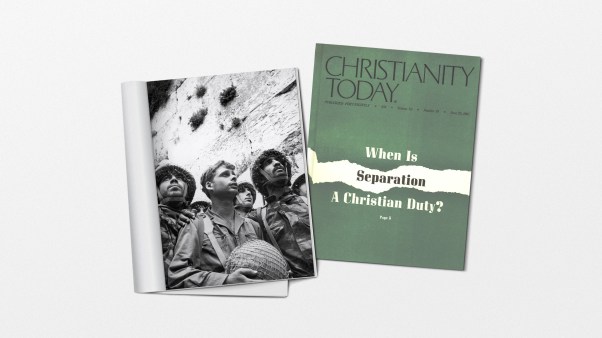We live in a world full of public trauma and tragedy. Most mornings, we wake up to discover newsfeeds and social media accounts churning with fear, anger, guilt, and shame rooted in a long list of persistent social problems. In this age of ubiquitous information, our heads and hearts are quickly flooded by the rising waters of evil and injustice.
A decade ago, I began to record every time I heard the statement “The church is so silent about X.” My anecdotal list is now very long. That phrase has been used repeatedly to introduce discussions about sexual abuse and harassment, racism, creation care and environmental justice, religious persecution, and more.
To be sure, there are lots of Christians talking about these things in lots of different settings. And yet, complaints about the church’s complicit silence often ring true simply because these issues aren’t always showing up in public worship.
Painfully, in the worship of far too many churches, there is barely even a mention of the world’s horrors. Instead of lamenting, confessing, and interceding with specificity and honesty, these churches tend to avoid, deny, or minimize the public trauma that is all around them. The understandable desire for a respite from trauma ends up perpetuating a pattern of disengagement from society.
There are many interrelated reasons for this liturgical silence. First, some churches operate with a thin, individualistic view of the gospel, focusing nearly all their liturgical attention on individual conversion and comfort. Second, some churches are conflict avoidant and eager to stay away from public controversy during worship. A third, perhaps underappreciated, reason is a pronounced decline in public intercessory prayer.
In many worship contexts today, intercessory prayer has fallen on hard times. It is stunning how often my students report that while their churches have robust practices of congregational singing and preaching, they include almost no prayer at all in public worship. They say their churches will pray about the physical health needs of members but never mention any larger societal concerns.
There are many good arguments for reviving a weekly practice of public intercession that is deeply conversant with the world outside the walls of the sanctuary: It aligns our prayers with the breadth of divine concern, it forms us into people of priestly concern for the world God loves, and it responds directly to biblical commands to pray in and about all circumstances.
Comprehensive prayer
In the early centuries of the church, public worship services routinely featured intercessory prayers for public needs, issues, and leaders. These prayers were grounded in a vision of the church as the gathering of a “royal priesthood” (1 Pet. 2:9), responding to God’s call to be a people bringing the needs of the world to God.
These prayers were shaped by New Testament commands that emphasize the comprehensiveness of prayer: “Pray in the Spirit at all times in every prayer and supplication. To that end keep alert and always persevere in supplication for all the saints” (Eph. 6:18, NRSV unless otherwise indicated); and “in everything by prayer and supplication with thanksgiving let your requests be made known to God” (Phil. 4:6). Although liturgical prayers were offered for the church and its ministries (Matt. 9:38), prayers also explicitly focused on the needs and callings of those outside the church, following Paul’s injunction: “I urge, then, first of all, that petitions, prayers, intercession and thanksgiving be made for all people—for kings and all those in authority, that we may live peaceful and quiet lives in all godliness and holiness” (1 Tim. 2:1–2, NIV).
Documents describing worship in the early church routinely include wide-ranging litanies and other prayer forms that bring before God the travails of the world. These early prayers ask for God’s mercy and reinforce a sense that human agency alone is insufficient to heal the pain of the world’s trauma. These early patterns of priestly intercession have been refined in diverse ways across Christian traditions through the centuries and across cultures.
In the Reformed tradition, John Calvin’s 1542 Form of Church Prayers sets the pace. It calls for a 1,500-word intercessory prayer each week after the Sunday sermon. There, Calvin fuses two liturgical traditions into a single prayer, opening with an extended paraphrase of the Lord’s Prayer and concluding with a set of petitions covering a wide range of personal, ecclesial, and civic topics. Both sections are notable for their comprehensive vision of what Christians can and should pray for in light of God’s far-reaching work in the world. Calvin’s comprehensive approach to public intercessions on Sunday was complemented by an additional prayer service held during the week, which included a similarly robust approach to intercessory prayers for public life.
All told, the prayers and songs of the early Reformers were meant to spill out of the sanctuary and into the public lives of the people. Reformed Christians were encouraged to turn the melodies they learned at church into the soundtrack by which they lived their lives—whistling them at work, singing them at school, repeating them at domestic mealtimes—in contrast to medieval Roman Catholic practices, which restricted the singing of sacred liturgical songs to the sanctuary.
For Calvin, prayer and action were intertwined with his theological understanding of the priesthood of all believers. Calvin describes prayer as an opportunity to “testify, by our request, that we do hate and lament all that we see to be opposed to the will of God.” He urges believers to pray for a breadth of public concerns, declaring, “It is by the benefit of prayer that we have an entrance into the riches which we have in God. … God does not tell us anything which we are to hope from Him, without likewise commanding us to ask for it by prayer.”
Cherishing how all our prayers are gathered up into the intercessions of Christ who “intercedes for us at God’s right hand” (drawing from Romans 8:34), Calvin advocates intercession: “God not only allows each individual to pray for himself, but allows all to intercede mutually for each other.” Calvin scholar Elsie McKee has explained that while Calvin’s earliest writings stress the importance of these intercessions in private or personal prayer, later writings insist that a comprehensive concern for the world’s needs should also be reflected in the public prayers of the church.
What Calvin and his contemporaries bequeathed to the Reformed tradition of prayer was, then, both a public theological vision of praying for the needs of the world and a set of liturgical practices to embody that public theology. A generation after Calvin, the 1563 Palatinate Order of Worship featured a “Prayer for All Needs and Concerns of Christendom,” which was emulated in the “Prayer for the General Needs of Christendom” in Dutch Reformed service books of the 1580s and beyond. Both of these are counterparts to Thomas Cranmer’s “Prayer for the Whole State of Christ’s Church Militant,” a notable text in the Book of Common Prayer.
Two centuries later, the 1772 Liturgy of the French Protestant Church featured a weekly prayer that conveyed petitions (1) for all people, (2) for all ministers, (3) for all in political authority, (4) for all who suffer from various afflictions, (5) for the country, and finally (6) for “the duties and business of our several callings.” Still later, the 1906 Presbyterian Book of Common Worship called for a weekly prayer, featuring “Supplications: for the supply of all our needs temporal and spiritual, and for the aid and comfort of the Holy Ghost in all our duties and trials,” as well as a robust list of public intercessions
for the whole world of mankind; remembering especially our country and all who are invested with civil authority; the Church Universal and that with which we are particularly connected; all missionaries and ministers of the Gospel; and all others who are seeking to do good on earth; all poor and sick and sorrowful people (especially those for whom our prayers are asked); all little children and the youth assembled in schools and colleges; those who are in the midst of great danger or temptation; and all who are bound to us by ties of kinship or affection.
At its best, this tradition of public intercession was a part of a larger set of Reformed connections between worship and public life. This included public preaching that addressed the people’s daily habits and concerns. It also included hymns and songs intentionally composed for the laity’s use, not simply in the sanctuary, but also in the workplace and in homes. These public liturgies were the result of a public theology that had a comprehensive vision of God’s redemptive activity.
Indeed, one of the most reliable guides to our understanding of God’s intentions for the world can be found in what we pray for. Put another way, our public prayers reveal our public theology. In the things they mention (and fail to mention), these prayers demonstrate precisely which elements of public life we believe God truly cares about.
To be sure, these comprehensive prayers of intercession have an uneven history in the Reformed tradition. They have been ignored, shortened, and contested. Yet, despite all the vagaries and complexities, one constant is an aspirational desire for public prayers that convey comprehensive civic and public concern while resisting escapism and sentimentality. The 360-degree vision challenges contemporary churches and worship leaders to pray in a way that is consistent with the breadth and depth of the gospel we preach.
Promising strategies
It goes without saying that public intercessions from Calvin’s Geneva or John Knox’s Edinburgh won’t always make a natural fit for 21st-century congregations in Jakarta, Seoul, New York, and Rio de Janeiro. That said, their intercessions can challenge us to develop faithful and culturally appropriate approaches to comprehensive prayers in our unique contexts. Indeed, their value can be conveyed in the form of a proverb or beatitude: “Blessed is the Christian community whose public prayer is comprehensive in concern, with requests for divine action that match the full range of divine activity narrated in Scripture.”
That proverb, in turn, sets in motion any number of promising liturgical strategies, including some quite different from Calvin’s. Once I visited a nondenominational church-planting ministry in which a wise pastor had paused early in a new church’s life to establish a robust practice of public intercessory prayer. Every week the church paused to pray about a specific public topic or concern beyond its own ministry context. Before the prayer, the pastor conducted brief interviews with people outside the congregation who were at work addressing that concern; then the church prayed for them and the situation they were seeking to improve. By the end of each year, because of this simple weekly pattern, that congregation had prayed for 52 concrete matters of public concern.
In another congregation, four people gather every Saturday morning at a local coffee shop to choose which newspaper headlines will be used to call the congregation to prayer. Each week they choose three headlines of national and international concern, three local headlines, and three headlines from the church’s newsletter about local ministry.
On Sunday, these nine headlines are projected onto a large screen, and a worship leader offers a one-sentence prayer on each of them, such as this one: “Lord God, have mercy on our local public schools, and equip each teacher and staff member who serves there to create a loving, just, patient, and transformative culture for every student.” These nine single-sentence prayers, structurally similar to several ancient litanies, influence worshipers to go into public life and continue praying (and looking) for God’s redemptive agency in all spheres of life.
These contemporary practices of intercession take Calvin’s comprehensive approach to public prayer and creatively add to it a concern for public specificity. Adding this pastoral wisdom to our earlier beatitude, we might say, “Blessed is the Christian community whose public prayer is comprehensive in concern (with requests for divine action that stretch toward the full range of divine activity narrated in Scripture) and also specific in focus (calling to mind particular places, people, and needs).”
One common attribute among pastorally and publicly sensitive prayer leaders is their intuition to deepen the stark contrast between public lament and public hope, even within the very same prayer. Their prayers about public life are both profoundly dark and bright. Their words of intercession tell the harsh truths about public evil and suffering and the blindingly good news about a God who will one day wipe away every public tear.
This involves a greater comfort with stammering in public prayer and a greater willingness to publicly admit our utter inadequacy and speechlessness in the face of horror. If we honestly face the world’s evils, one of the first things we must say to God is, “We do not know what to say. We don’t know how to pray.” How, for instance, does a person pray after the Holocaust? Or after a gunman walks into a synagogue and murders people at prayer?
It is a gift to the church when poised pastoral leaders say, “God of grace, we are at a loss for words. … We do not know how to pray as we ought. How we need the Spirit, who ‘intercedes with sighs too deep for words’” (Rom. 8:26–27).
To refine our proverb once more: “Wise is the community that prays for concerns as far-reaching as the scope of divine redemption, that names specific human horrors and traumas, and that practices both its fragmentary aching laments and God’s ultimate eschatological promises.”
Beyond Sunday morning
If we are going to engage the world’s horrors, we need habits and patterns of prayer that routinely acknowledge and speak them out loud. This models an approach to prayer that can echo all week long in the lives of individual believers. At its best, public intercession is a hyperconcentrated expression of a congregation’s engaged stance toward the world, one that radiates outward far beyond Sunday morning.
After all, changing our public prayers is entirely insufficient unless they are paired with public action. Prayer only becomes compelling and formative within a community when it is matched with redemptive ways of life. It is not always clear which comes first. At some times, a community begins to feed the hungry and later becomes convicted to pray about the causes of systemic poverty. At other times, a pastor may lead a congregation in prayer about this issue, and that might prompt an informal discussion about gaps in local support services, gaps the church might fill. Either path calls for God’s people to intercede before God on behalf of the world.
Through the weekly practice of public prayer, diverse congregations carry diverse public traumas before God and pursue their priestly calling in the ministry of intercession. In so doing, they embody and enact their priesthood in Christ, a public priesthood that is commanded and empowered to cross the road and help a neighbor in need.
John Witvliet is director of the Calvin Institute of Christian Worship at Calvin University. This article is adapted from his chapter in Reformed Public Theology: A Global Vision for Life in the World, edited by Matthew Kaemingk. Published by Baker Academic, a division of Baker Publishing Group, © 2021. Used by permission of the publisher. www.bakerpublishinggroup.com.








